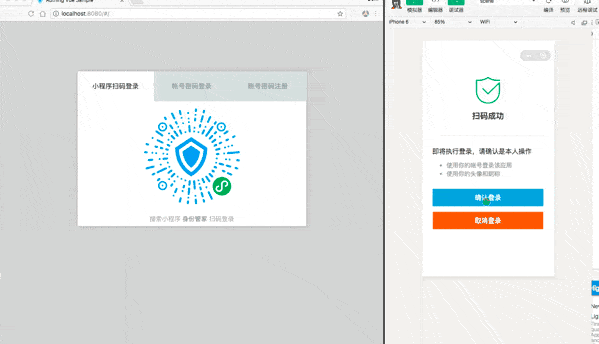Authing 的 JavaScript SDK 支持 Angular.js,React.js,Vue.js 以及 浏览器原生环境。我们提供了完全一致的接口.
当构建大规模应用时,我们推荐使用 npm 进行安装, 它可以与一些模块打包工具很好地配合使用,如 Webpack, Browserify。
# latest stable
$ npm install authing-js-sdk --save先从 Authing 控制台 中获取用户池 ID。
为保证 secret 安全,在服务端的初始化和客户端的初始化有所不同。
服务端可直接传入 userPoolId 和 secret。
const auth = new Authing({
userPoolId: 'your_userpool_id',
secret: 'your_userpool_secret'
});
auth.register({...}).then(info => {})
auth.login({...}).then(info => {})客户端只允许调用部分函数,无权调用一些用户池管理函数,如删除用户,获取全部用户列表等。
- userPoolId - 用户池 ID,可从 Authing 控制台中获取。
const auth = new Authing({
userPoolId: 'your_userpool_id'
});
auth.register({...}).then(info => {})
auth.login({...}).then(info => {})Authing SDK 的所有 API 都支持 Promise。
const Authing = require('authing-js-sdk');
// 对 用户池 ID 和 用户池 Secret 进行验证,获取 Access Token
const auth = new Authing({
userPoolId: 'your_userpool_id',
secret: 'your_app_secret',
});
auth
.login({
email: 'test@testmail.com',
password: 'testpassword'
})
.then(function(user) {
console.log(user);
})
.catch(function(error) {
console.log(error);
});如果你使用 ES6+ 推荐用 await 处理异步,示例如下:
import Authing from 'authing-js-sdk';
const main = async () => {
//使用async时需要使用 try...catch... 捕捉错误
let auth = new Authing({
userPoolId: 'your_userpool_id',
secret: 'your_app_secret'
});
if (auth) {
let user;
try {
user = await auth.login({
email: 'test@testmail.com',
password: 'testpassword'
});
} catch (error) {
console.log('登录失败:', error);
}
if (user) {
console.log('login success');
} else {
console.log('login failed');
}
}
};
main();Authing SDK 的默认请求超时时间是 10s,如果想加大或减小超时时间,请在 SDK 中指定 timeout 参数,以下以在浏览器中初始化为例:
const auth = new Authing({
userPoolId: 'your_userpool_id',
timeout: 20000 // 20 秒超时
});
auth.register({...}).then(info => {})
auth.login({...}).then(info => {})- preflight - 是否开启网络状况预检,默认为 false。此参数适用于检查用户的网络是否屏蔽了 authing.cn 这个域名(某些企业的内网会屏蔽这个域名),检查成功不进行任何通知,检查失败后会调用传入的错误处理函数。执行预检之后会导致 SDK 初始化速度变慢,请谨慎使用。
- cdnPreflight - 是否开启 CDN 网络状况预检,默认为 false。此参数适用于检查用户的网络是否可以访问七牛云 CDN(某些开了代理的场景下无法访问),检查成功不进行任何通知,检查失败后调用传入的错误处理函数。执行 CDN 预检之后会导致 SDK 初始化速度变慢,请谨慎使用。
- timeout
- 超时时间,默认为 10000(10 秒)。
- onInitError,
function(err) {}- 错误处理函数,用于处理初始化失败错误、预检错误。
全部 API 请参考:Javascript 版用户接口, Node.js 版用户接口。
小程序扫码登录指使用 Authing 小程序 身份管家 执行微信登录。
示例:小程序扫码登录
使用 startWXAppScaning 方法:
import Authing from 'authing-js-sdk';
const authing = new Authing({
userPoolId: 'your_userpool_id'
});
authing.startWXAppScaning({
enableFetchPhone: true // 启用获取手机号
mount: 'qrcode-node', //二维码挂载点的 HTML 元素 ID,如不写则默认漂浮在文档中间
});扫码完成后会自动跳到用户配置的 URL 上。
authing.startWXAppScaning({
mount: 'qrcode-node', // 二维码挂载点,如不写则默认漂浮在文档中间
redirect: true, // 是否执行跳转(在用户后台配置的 URL),默认为 true,相关用户信息回传至 url 上
onSuccess: function(res) {}, // 登录成功后回调函数,redirect 为 true 时不回调此函数
onError: function(error) {}, // 登录失败后回调函数,一般为网络问题
onIntervalStarting: function(intervalNum) {}, // 轮询时的回调函数,intervalNum 为 setInterval 返回的数值,可使用 clearInterval 停止轮询
onQRCodeLoad: function(qRcode) {}, // 小程序码获取成功后的回调函数,qRcode 为小程序码的相关信息,是一个对象
onQRCodeShow: function(qRcode) {}, // 小程序码图片加载完成后的回调函数,qRcode 为小程序码的相关信息,是一个对象
interval: 1500, // 每隔多少秒检查一次,默认 1500
enableFetchPhone: false, // 是否支持获取手机号(使用小登录扫码)
useSelfWxapp: false, // 私有化部署了小程序的用户请将此参数设置为 true
tips: '使用微信扫码登录', // 提示信息,可写 HTML
successTips: '扫码成功', // 扫码成功的提示信息,默认:扫码成功
successRedirectTips: '扫码成功,即将跳转', // 扫码成功后跳转前的提示信息,默认:扫码成功,即将跳转
retryTips: '重试', // 重试扫码的提示信息,默认:重试
failedTips: '网络出错,请重试' // 扫码失败的提示信息,默认:网络出错,请重试
});若想动态修改提示信息,请使用以下四个方法:
// 修改重试扫码的提示信息
authing.updateRetryTips(tips: string)
// 修改扫码失败的提示信息
authing.updateFailedTips(tips: string)
// 修改扫码成功的提示信息
authing.updateSuccessTips(tips: string)
// 修改扫码成功后跳转前的提示信息
authing.updateSuccessRedirectTips(tips: string)了解更多,请查看:使用小程序扫码登录
Authing 构造函数包含一个名为 host 对象,可接收自定义的请求链接(适合私有部署 Authing 的用户使用),使用方法如下:
const auth = new Authing({
userPoolId: 'xxxx',
secret: 'xxxxxx',
host: {
user: 'https://users.authing.cn/graphql',
oauth: 'https://oauth.authing.cn/graphql'
}
});host 对象中 user 和 oauth 的默认值是 Authing 官方的请求链接:
当在浏览器使用时,我们会将用户 token 以 '_authing_token' 字段存在 localStorage 中,后面都会从 localStorage 中读取并进行验证。
了解更多报错的详情,请查看错误代码。
获取用户池 ID 和用户池 Secret,请点击这里。
- Join us on Gitter: #authing-chat

